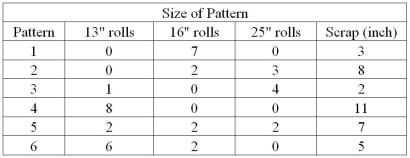Use the scenario below to answer the following question(s) .
A company makes standard 115-inch-wide rolls of thin sheet metal,and slits them into smaller rolls to meet customer orders for widths of 13,16,and 25 inches.The demands for these widths vary from week to week.From a 115-inch roll,there are many different ways to slit 13-,16-,and 25-inch pieces.
A cutting pattern is a configuration of the number of smaller rolls of each type that are cut from the raw stock.Of course,one would want to use as much of the roll as possible to avoid costly scrap.For example,one could cut seven 16-inch rolls,leaving a 3-inch piece of scrap.Finding good cutting patterns for a large set of end products is in itself a challenging problem.Suppose that the company has proposed the following cutting patterns:  Demands this week are 1,000 13-inch rolls,1,430 16-inch rolls,and 1,260 25-inch rolls.The problem is to develop a model that will determine how many 115-inch rolls to cut into each of the six patterns in order to meet demand and scrap.
Demands this week are 1,000 13-inch rolls,1,430 16-inch rolls,and 1,260 25-inch rolls.The problem is to develop a model that will determine how many 115-inch rolls to cut into each of the six patterns in order to meet demand and scrap.
Define Xi to be the number of 115-inch rolls to cut using cutting pattern i,for i = 1,…,6.
Note that Xi needs to be a whole number because each roll that is cut generates a different number of end items.
-Determine the constraint modeled for 25-inch rolls.
Definitions:
Reinforce Behaviour
The process of encouraging or establishing a pattern of behavior by offering rewards or consequences.
Negative Reinforcement
A behavioral psychology principle where the removal of an unpleasant stimulus following a desired behavior increases the likelihood of that behavior being repeated in the future.
Punishment
A consequence that reduces the likelihood of a behavior being repeated, often used in behavioral conditioning.
Positive Reinforcement
A technique in behaviorism that encourages a certain behavior by following it with a positive stimulus or reward.
Q9: Which of the following,if true,would suggest that
Q10: Suppose you took a functionalist perspective.How would
Q22: Explain instances where we have to use
Q32: Using Solver,determine the number of 115-inch rolls
Q36: A problem is unbounded if the objective
Q54: Arora was placed in a residential boarding
Q55: Show the steps required to calculate the
Q63: In the context of efficiency evaluation of
Q106: Which of the following initiatives would address
Q138: Andrea is studying education from a functionalist